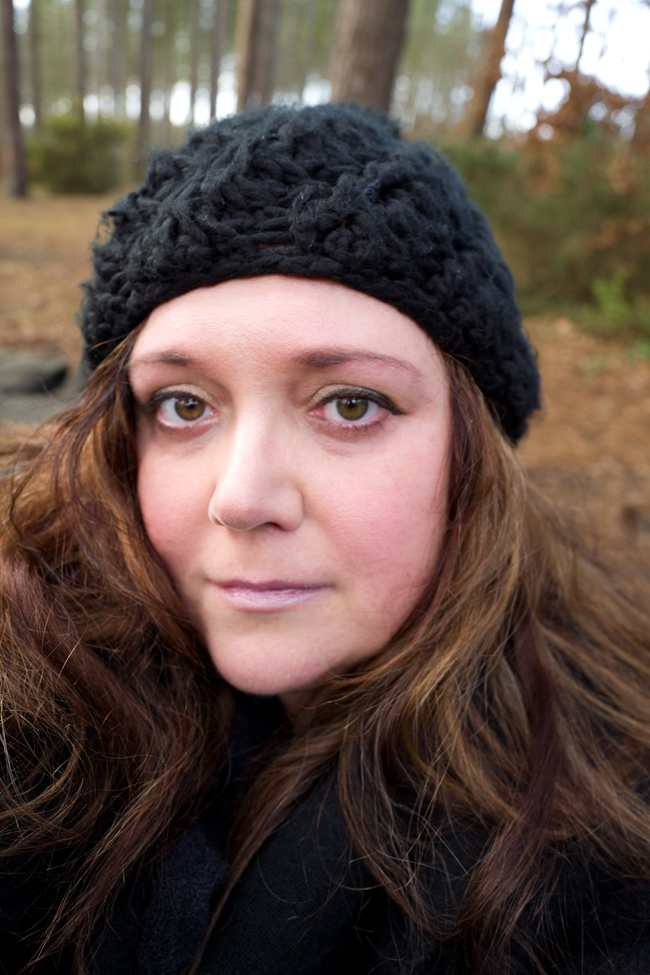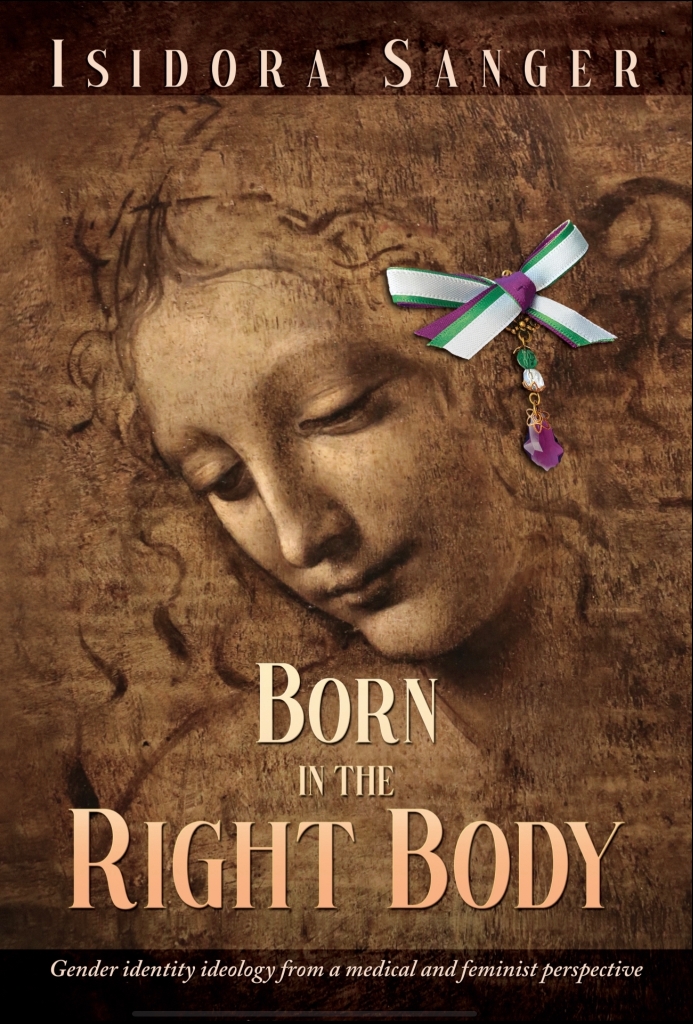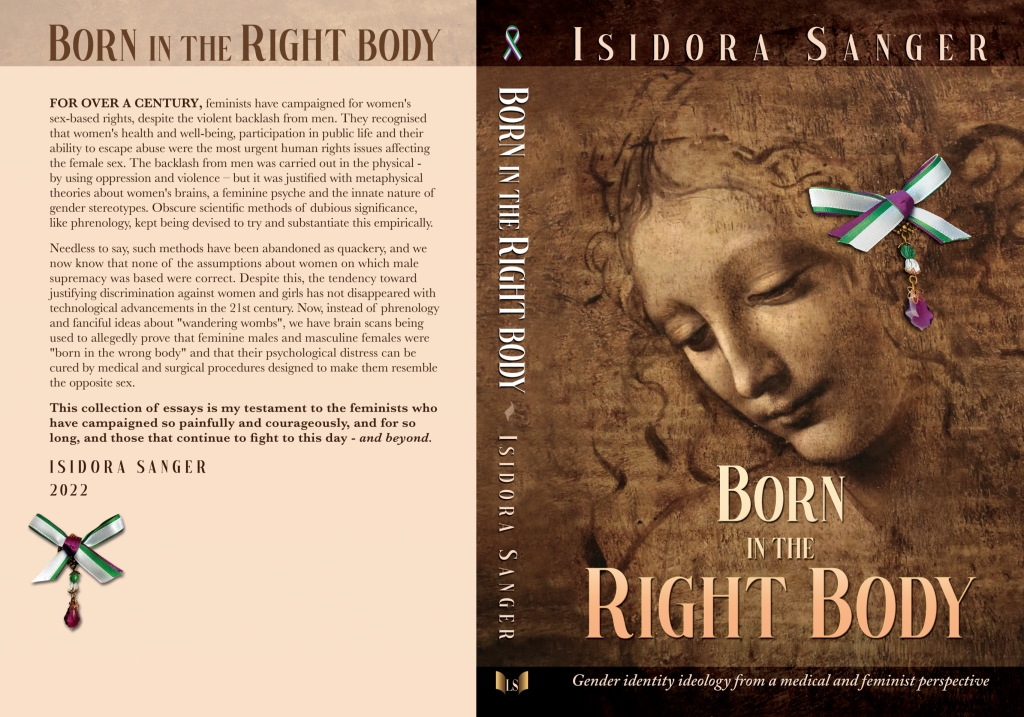An interview with an author is long overdue on this blog, so I am delighted to introduce you to the author who writes under the name of Isidora Sanger, and is known to her many followers online as laScapigliata*

Isidora is a medical doctor who retired early due to some chronic health issues. She always wanted to be a writer and started writing fiction as soon as she went on her first long-term sick leave.
Around 2012 she became aware of a growing discourse around transgender issues, and became concerned about ethics and the evidence-base for gender self-identification and gender reassignment interventions. She decided to look into it further and has since written about various issues connected to that topic.
Welcome to the blog Isidora. I have just finished reading your book, and found your essays so well researched and well argued that I am happy to recommend them to others who want to look more deeply into this issue.
What is the title of your book? Born in the Right Body: Gender identity ideology from a medical and feminist perspective. The book explores the impact of the transgender phenomenon, gender self-identification, and gender identity ideology on patient welfare and women’s sex-based rights. It examines the evidence-base for gender reassignment interventions using a first principles approach. It tracks the cognitive and policy capture of Western institutions by gender identity ideology, and it applies the feminist lens to consequences and outcomes of individuals identifying as the opposite sex.

Why did you write it? In 2012 I first noticed men who identified as women starting to abuse feminists online. A woman could not say that women have unique biology and healthcare needs, and that female biology makes women vulnerable to abuse, without being called a “TERF” – which stands for “trans-exclusionary radical feminist” – “bigot” and even “Nazi”.
Having been a feminist for a long time, the insults and threats these men (who called themselves “transwomen”) hurled at women reminded me of Men’s Rights Activists and “incels”, who had been abusing feminists online for years beforehand. However, instead of being universally condemned in feminist circles, they were often being celebrated as “the most oppressed minority in history,” and allowed to take over women’s groups and conversations.
Soon, the word “transwoman” changed spelling to “trans woman” and transactivists started to claim that men who identified as women were in fact female, and that “trans” was just an adjective, like “Black”, “tall” and “disabled”. Simultaneously, the word “woman” started to disappear from healthcare and policy. Woman became “anyone who identifies as a woman”, and while women were being described using dehumanising terms such as “menstruators”, “vulva owners” and “birthing bodies”, the word “man” remained intact.
A massive surge in children and adolescents (and especially girls) identifying as the opposite sex followed, and gender clinics world-wide started to follow a so called “affirmation-only model”. This involved automatic affirmation of opposite sex identities – without exploring underlying causes – and interventions designed to masculinise girls and feminise boys. I found that children and young people were having their normal development arrested through the use of puberty blockers, their physiology was being thrown out of balance with cross-sex hormones, and they were undergoing radical yet unnecessary surgical procedures such as castration and double mastectomies, all in a pursuit of the unattainable goal of a “sex change”.
The more I looked, the more I realised how damaging this was. These medical and surgical interventions had very serious long-term side effects (such as impairment in bone, brain and sexual development) and the evidence that this was improving psychological distress associated with “gender dysphoria” was lacking. I realised we were witnessing a medical scandal and as a doctor I felt it was my duty to raise awareness and fight it.
What have you found to be the most challenging aspects of being a writer? I find, as a bilingual person, writing in my second language is quite tiring. Even though I’m fluent in English, there’s a delay between an idea and words on the page. It is hard to explain, but I find that I have to focus a lot more when I’m writing in English, than when I’m writing in Serbo-Croatian, which is my native tongue.
I also didn’t quite appreciate how physically strenuous writing a book can be; finding a good chair and desk was essential.
And the most rewarding? Being able to express myself has been not just incredibly rewarding, but also healing. Once upon a time, I was a refugee in a foreign country whose language and customs I didn’t best understand. Not being able to crack a joke or express my feelings to others felt like I was “locked in”. It was a very surreal, frustrating feeling. Finding my voice again feels like a blockage has been cleared and my energy can once again flow freely.
Writing non-fiction allows me to contribute to the conversation about issues that are important to me. However, my happy place is fiction-writing. Creating new worlds and characters, and seeing others enjoy and derive personal meaning from it, is a great privilege.
What is your top tip for an aspiring writer? Find a story you can see yourself working on for at least 2 years, if not longer, because writing a book takes time. Every story can be told in countless ways. As writers we have to make choices every time we sit down to write, and it can be daunting to be aware of the choices we didn’t make, to doubt ourselves and even, to start again. The story has to really grab you, it has to remain exciting and motivate you over a long period of time. So, write what you want to read, and what you can see yourself thinking about day after day for the foreseeable future.
What do you like to read? I read quite widely. I love literary novels but also genre fiction, especially mystery, supernatural and science fiction. Some of my all-time favourite novels are The Wind-up Bird Chronicle by Haruki Murakami, Dictionary of Khazars by Milorad Pavic, The Three Musketeers by Alexander Dumas, Americanah by Chimamanda Ngozi Adiche, Jane Eyre by Charlotte Bronte, Crime and Punishment by Fjodor Dostoyevsky, Dracula by Bram Stoker, Dune by Frank Herbert and The Three-Body Problem trilogy by Liu Cixin.
What are you working on at the moment? I’m working on a story about a female vampire who lost her memory. The story is set in the future, with flashbacks to the past and a sci-fi subplot. But in essence it is a story about a mother and son, about survival and about being a woman.
I look forward to featuring this new work on the blog one day! Meanwhile, where can readers find you and your recent book?
You can find me on twitter as @lascapigliata8
My website is lascapigliata.com
My book is available in bookstores such as Waterstones, Barnes and Noble, and in all Amazon marketplaces.
The link to UK Amazon listing is https://www.amazon.co.uk/Born-Right-Body-identity-perspective-ebook/dp/B0BN2FJDTX/)
A Synopsis from Born in the Right Body
For over a century, feminists have campaigned for women’s sex-based rights, despite the violent backlash from men. They recognised that women’s health and well-being, participation in public life and their ability to escape abuse were the most urgent human rights issues affecting the female sex. The backlash from men was carried out in the physical – by using oppression and violence – but it was justified with metaphysical theories about women’s brains, a feminine psyche and the innate nature of gender stereotypes. Obscure scientific methods of dubious significance, like phrenology, kept being devised to try and substantiate this empirically.
Needless to say, such methods have been abandoned as quackery, and we now know that none of the assumptions about women on which male supremacy was based were correct. Despite this, the tendency toward justifying discrimination against women and girls has not disappeared with technological advancements in the 21st century. Now, instead of phrenology and fanciful ideas about “wandering wombs”, we have brain scans being used to allegedly prove that feminine males and masculine females were “born in the wrong body” and that their psychological distress can be cured by medical and surgical procedures designed to make them resemble the opposite sex.
This collection of essays is my testament to the feminists who have campaigned so painfully and courageously, and for so long, and those that continue to fight to this day – and beyond.

NB: *[Editor’s note] La Scapigliata is an unfinished painting attributed to Leonardo da Vinci. Through it, Leonardo is suggesting there is much more to the female race than society understands and appreciates.